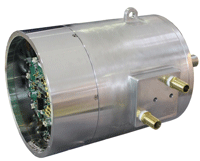- News
8 March 2012
Built-in SiC inverter halves size of Mitsubishi Electric’s EV motor system
 Tokyo-based Mitsubishi Electric Corp has developed a prototype electric vehicle (EV) motor system with a built-in silicon carbide (SiC) inverter. The EV motor system is claimed to be the smallest of its kind, measuring just half the size of Mitsubishi Electric’s existing motor system (which uses an external inverter), and loss is less than half that of silicon-based systems.
Tokyo-based Mitsubishi Electric Corp has developed a prototype electric vehicle (EV) motor system with a built-in silicon carbide (SiC) inverter. The EV motor system is claimed to be the smallest of its kind, measuring just half the size of Mitsubishi Electric’s existing motor system (which uses an external inverter), and loss is less than half that of silicon-based systems.
The new motor system is expected to enable manufacturers to develop EVs offering more passenger space and greater energy efficiency. The firm plans to commercialize the motor system after finalizing other technologies for motor/inverter cooling, downsizing and efficiency.
Global demand for EVs and hybrid EVs (HEVs) has been growing in recent years, reflecting increasingly strict regulation of fuel efficiency and the growing public interest in saving energy resources and reducing carbon dioxide emissions, says Mitsubishi Electric. As EVs and HEVs require relatively large spaces to accommodate the robust battery systems, there is a strong need to reduce the size and weight of motor systems and other equipment to ensure that there is sufficient room in passenger compartments.
Mitsubishi Electric’s says that key developments of the new EV motor system include the following:
1. The existing system consists of separate motors and inverters driving the motors, requiring more space for these components and their wiring. The new cylinder-shaped inverter matches the diameter of the motor, enabling it to be connected coaxially within a chassis, halving the size of the system.
2. Silicon chips have been widely used in power devices for inverter switching, but SiC is now recognized as a more suitable material for chips due to its electrical characteristics, including a breakdown electric field that is 10 times greater, allowing thinner chips (reducing electrical resistance and lowering loss). All power chips in the inverter are SiC-based, more than halving inverter loss compared to the firm’s silicon-based system.
3. The permanent magnet motor uses a neodymium magnet. Mitsubishi Electric’s proprietary dense-winding structure enabled it to use its poki-poki motor production technologies to reduce the motor’s size. The size and configuration of the stator and rotator poles were optimized using Mitsubishi Electric’s high-level magnetic-design technology. Magnetic efficiency was hence increased and power output improved by 5% over previous motors.
